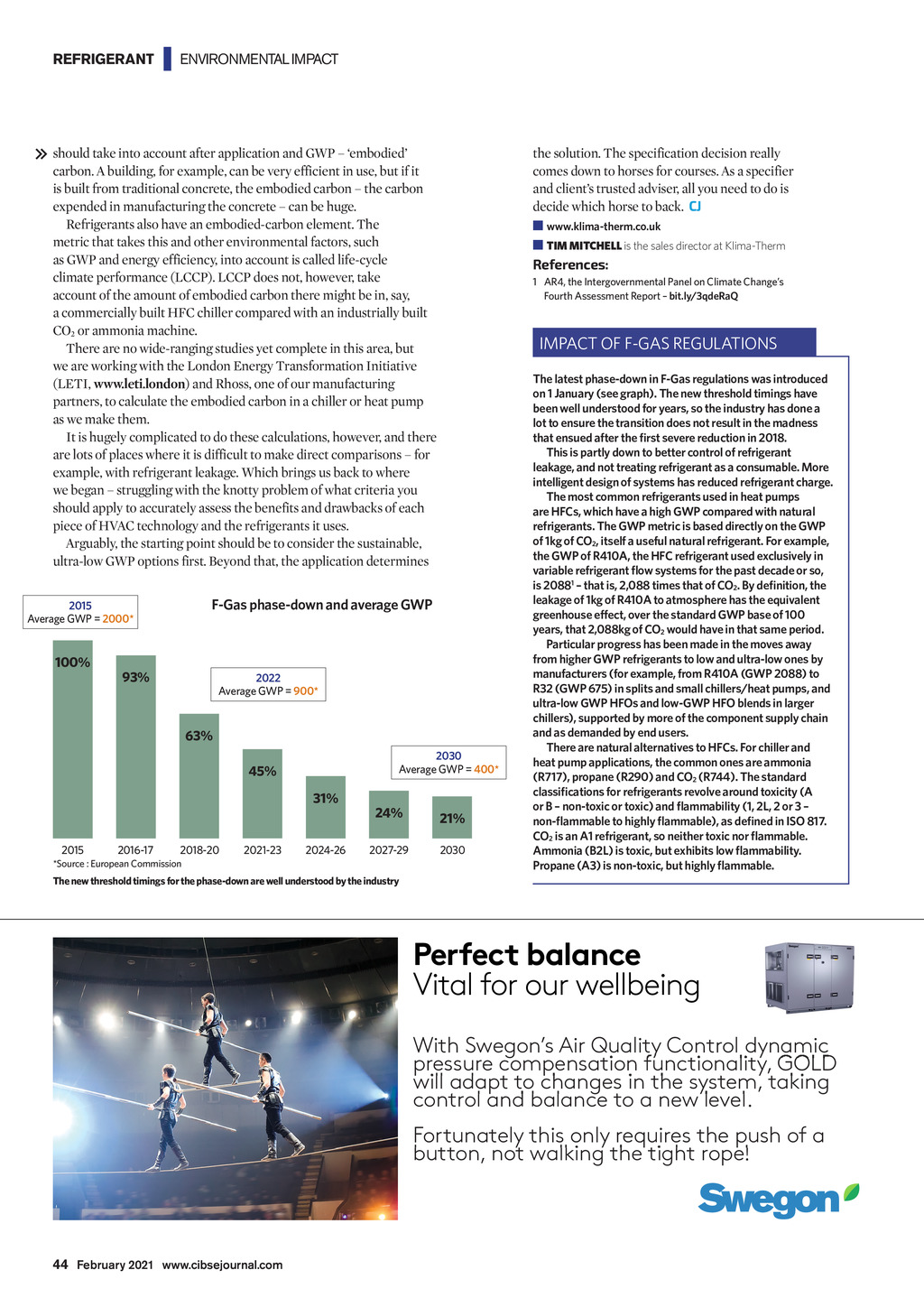




REFRIGERANT | ENVIRONMENTAL IMPACT should take into account after application and GWP embodied carbon. A building, for example, can be very efficient in use, but if it is built from traditional concrete, the embodied carbon the carbon expended in manufacturing the concrete can be huge. Refrigerants also have an embodied-carbon element. The metric that takes this and other environmental factors, such as GWP and energy efficiency, into account is called life-cycle climate performance (LCCP). LCCP does not, however, take account of the amount of embodied carbon there might be in, say, a commercially built HFC chiller compared with an industrially built CO2 or ammonia machine. There are no wide-ranging studies yet complete in this area, but we are working with the London Energy Transformation Initiative (LETI, www.leti.london) and Rhoss, one of our manufacturing partners, to calculate the embodied carbon in a chiller or heat pump as we make them. It is hugely complicated to do these calculations, however, and there are lots of places where it is difficult to make direct comparisons for example, with refrigerant leakage. Which brings us back to where we began struggling with the knotty problem of what criteria you should apply to accurately assess the benefits and drawbacks of each piece of HVAC technology and the refrigerants it uses. Arguably, the starting point should be to consider the sustainable, ultra-low GWP options first. Beyond that, the application determines 1AR4, the Intergovernmental Panel on Climate Changes Fourth Assessment Report bit.ly/3qdeRaQ IMPACT OF F-GAS REGULATIONS F-Gas phase-down and average GWP 2015 Average GWP = 2000* 100% the solution. The specification decision really comes down to horses for courses. As a specifier and clients trusted adviser, all you need to do is decide which horse to back. CJ www.klima-therm.co.uk TIM MITCHELL is the sales director at Klima-Therm References: 93% 2022 Average GWP = 900* 63% 2030 Average GWP = 400* 45% 31% 2015 2016-17 2018-20 2021-23 2024-26 24% 21% 2027-29 2030 *Source : European Commission The latest phase-down in F-Gas regulations was introduced on 1 January (see graph). The new threshold timings have been well understood for years, so the industry has done a lot to ensure the transition does not result in the madness that ensued after the first severe reduction in 2018. This is partly down to better control of refrigerant leakage, and not treating refrigerant as a consumable. More intelligent design of systems has reduced refrigerant charge. The most common refrigerants used in heat pumps are HFCs, which have a high GWP compared with natural refrigerants. The GWP metric is based directly on the GWP of 1kg of CO2, itself a useful natural refrigerant. For example, the GWP of R410A, the HFC refrigerant used exclusively in variable refrigerant flow systems for the past decade or so, is 20881 that is, 2,088 times that of CO2. By definition, the leakage of 1kg of R410A to atmosphere has the equivalent greenhouse effect, over the standard GWP base of 100 years, that 2,088kg of CO2 would have in that same period. Particular progress has been made in the moves away from higher GWP refrigerants to low and ultra-low ones by manufacturers (for example, from R410A (GWP 2088) to R32 (GWP 675) in splits and small chillers/heat pumps, and ultra-low GWP HFOs and low-GWP HFO blends in larger chillers), supported by more of the component supply chain and as demanded by end users. There are natural alternatives to HFCs. For chiller and heat pump applications, the common ones are ammonia (R717), propane (R290) and CO2 (R744). The standard classifications for refrigerants revolve around toxicity (A or B non-toxic or toxic) and flammability (1, 2L, 2 or 3 non-flammable to highly flammable), as defined in ISO 817. CO2 is an A1 refrigerant, so neither toxic nor flammable. Ammonia (B2L) is toxic, but exhibits low flammability. Propane (A3) is non-toxic, but highly flammable. The new threshold timings for the phase-down are well understood by the industry Perfect balance Vital for our wellbeing With Swegons g Air Qualityy Control dynamic y pressure compensation p p functionality, y, GOLD will adapt p to changes g in the system, y taking control and balance to a new level. Fortunatelyy this onlyy requires q the push p of a button, not walking the tight rope! 44 February 2021 www.cibsejournal.com CIBSE Feb21 pp43-44 Natural refrigerants.indd 44 22/01/2021 15:49